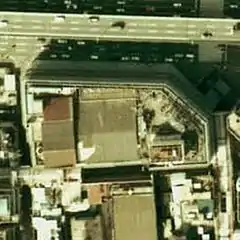Sennichi Department Store Building fire
The Sennichi Department Store Building fire occurred in Sennichimae, Minami-ku (now Chuo-ku), Osaka, Japan on May 13, 1972.[1] The fire killed at least 118 people and injured another 78.[2] It was the worst department store fire in terms of casualties in Japan. The building that housed the department store also contained various other businesses, including a cabaret. All the victims had been in the cabaret.

Venue
At the time of the fire, there were shops directly run by the Sennichi Department Store in the first and second floors, supermarkets on the 3rd and 4th floors, stores of the same prices on the 5th floor, game corners on the 6th floor, a cabaret called "Playtown" which was run by an affiliated company, and a showroom "haunted house" and coffee house underground. It was a so-called "conglomerate building" with different administrators. The 6th floor was partly under construction to become a bowling alley and the 3rd floor was also under construction.
The building which had previously been a Kabuki theater had no fire sprinkler system. The existence of various different types of enterprises within one building was also a problem. The regulations and laws at the time of the construction of buildings collectively allowed these faults to occur.
Fire
It was Saturday night, and the seventh floor cabaret; the Play Town Club, was filled to capacity with 181 patrons,[3] as it was one of the most popular night spots in Osaka. There were partitions in the fire exits, but they did not work and the fire shutter, which was not automatic, did not work. The fire started at 22:27 in the third floor, where women's dresses were sold and where several electricians were working.[3] The cause of the fire was said to be a cigarette butt[4] or a smouldering match left behind by a construction worker. Immediate attempts to extinguish the fire failed. Notification to the fire station was delayed by 13 minutes and the fire department was informed of the fire at 22:40 and started firefighting at 22:43. By that time, the third and fourth floors were fuming black smoke. Women's dresses for sale caught fire and helped spread the fire. The four floors from the second to the fifth were ablaze.
Poisonous gas resulting from burning construction materials filled the stairway and caused the majority of casualties. The loss was exacerbated by the locked exits in the cabaret.[4] When elevators ceased to function after the fire severed power cables, the situation turned into a mass panic. Even though there were escape sliding bags were provided inside the cabaret, the safety equipment was not used properly, and evacuation directions were not given by the three cabaret workers familiar with the layout. Instead they fled utilizing the stairwell that many customers were unaware of.[2][3] Eyewitnesses on the streets recounted that many individuals had broken windows and climbed out and clung to the window ledges prior to firefighters arriving at the scene, with many falling to their deaths.[4]
Responding firefighters found that many victims may have not had the time to react to the fire, after entering the cabaret, discovering many victims without thermal burns and engaging in daily activities. They found a deceased victims sitting on a sofa holding a glass of whisky and another on the stage still holding onto the microphone.[3] About 49 individuals were evacuated via fire brigade ladders however many deaths were attributed to the use of the two tubular canvas shoots which caused the deaths of many due to misuse.[4]
Victims
Twenty-four people attempted to escape by jumping out of windows, about 20 people died while attempting to use an emergency escape chute which collapsed.[2] Ninety-six were found dead inside the cabaret.[3] The fire was brought under control the next day and finally extinguished on the third day. Of the dead, 93 suffered carbon monoxide poisoning,[1] three died from compression injuries in the chest and abdomen (meaning that they were probably trampled to death), and about 20 died from jumping.
Police told reporters that about 49 people have been rescued unhurt and 42 others were injured.[2] Of the injured, 27 were firemen.
Legal
Two people from the Sennichi Department Store and two people from the Playtown Cabaret were indicted for occupational negligence resulting in fire and casualties. On November 29, 1990, the remaining three persons were finally found guilty. A department administrator was sentenced to imprisonment for two years and six months with suspension of three years; two persons involved with the cabaret were sentenced to one year and six months with suspension of two years. One of the department store people died during the trial.
Aftermath
The 1972 Sennichi Department Store Building fire and the 1973 Taiyo Department Store fire, both of which caused many casualties, finally led to amendments of the Construction Standard Law and the Fire Fighting Law. These amendments dictated that steps must be taken to prevent the possibility of smoke hindering people who are trying to escape from a fire.
After the fire the building was demolished and another store; Bic Camera was built in its place and operates as a major electronics retailer. However, due to the tragedy many ghost stores about the victims of the fire are seen on the internet.[1]
References
- "Is one of Osaka's largest electronics stores haunted? Japanese netizens say sure, it's summer". SoraNews24 -Japan News-. 2013-08-07. Retrieved 2022-03-25.
- "118 Killed in Japan In a Nightclub Fire". The New York Times. 1972-05-14. ISSN 0362-4331. Retrieved 2022-03-25.
- Masellis, M (2007). The Management of Mass Burn Casualties and Fire Disasters: Proceedings of the First International Conference on Burns and Fire Disasters. Springer Netherlands. p. 39. ISBN 9780585339733.
- Russell, Henry (2001). World Disasters: Tragedies in the Modern Age. Taylor & Francis. ISBN 9781136742569.
- Database of failures "Sennichi Department Fire" by Tokyo University Professor Ken-ichi Horikawa (source of information, National Diet Library)